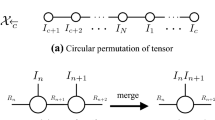Abstract
One of the main difficulties in tensor completion is the calculation of the tensor rank. Recently a tensor nuclear norm, which is equal to the weighted sum of matrix nuclear norms of all unfoldings of the tensor, was proposed to address this issue. However, in this approach, all the singular values are minimized simultaneously. Hence the tensor rank may not be well approximated. In addition, many existing algorithms ignore the structural information of the tensor. This paper presents a tensor completion algorithm based on the proposed tensor truncated nuclear norm, which is superior to the traditional tensor nuclear norm. Furthermore, to maintain the structural information, a sparse regularization term, defined in the transform domain, is added into the objective function. Experimental results showed that our proposed algorithm outperforms several state-of-the-art tensor completion schemes.





Similar content being viewed by others
References
Kim E, Lee M, Choi C-H, Kwak N, Oh Songhwai (2015) Efficient L1-norm-based low-rank matrix approximations for large-scale problems using alternating rectified gradient method. IEEE Trans Neural Netw Learn Syst 26(2):237–251
Li L, Li S, Fu Y (2013) Discriminative dictionary learning with low-rank regularization for face recognition. In: Proceedings of 10th IEEE international conference and workshops on automatic face and gesture recognition (FG), 2013, pp 1–6
Ma R, Barzigar N, Roozgard A, Cheng S (2014) Decomposition approach for low-rank matrix completion and its applications. IEEE Trans Signal Process 62(7):1671–1683
Liu G, Lin Z, Yan S, Sun J, Yu Y, Ma Y (2013a) Robust recovery of subspace structures by low-rank representation. IEEE Trans Pattern Anal Mach Intell 35(1):171–184
Coupier David, Desolneux Agnes, Ycart Bernard (2005) Image denoising by statistical area thresholding. J Math Imaging Vis 22(2–3):183–197
Tessens L, Pizurica A, Alecu A, Munteanu A, Philips W (2008) Context adaptive image denoising through modeling of curvelet domain statistics. J Electron Imaging 17(3):03021:1–03021:17
Efros A, Leung T (1999) Texture synthesis by non-parametric sampling. In: Proceedings of 7th international conference on computer vision 1999, pp 1033–1038
Liu J, Musialski P, Wonka P, Ye J (2013b) Tensor completion for estimating missing values in visual data. IEEE Trans Pattern Anal Mach Intell 35(1):208–220
Candès E, Recht B (2009) Exact matrix completion via convex optimization. Found Comput Math 9(6):717–772
Okatani T, Yoshida T, Deguchi K (2011) Efficient algorithm for low-rank matrix factorization with missing components and performance comparison of latest algorithms. In: Proceedings IEEE international conference computer vision, pp 842–849
Zhang Z, Ganesh A, Liang X, Ma Y (2012) Tilt: transform invariant low-rank textures. Int J Comput Vis 99(1):1–24
Ji H, Liu C, Shen Z, Xu Y (2010) Robust video denoising using low rank matrix completion. In: Proceedings of IEEE international conference computer vision and pattern recognition 2010, pp 1791–1798
Candès EJ, Tao T (2010) The power of convex relaxation: near-optimal matrix completion. IEEE Trans Inf Theory 56(5):2053–2080
Cai J-F, Candès EJ, Shen Z (2010) A singular value thresholding algorithm for matrix completion. SIAM J Optim 20(4):1956–1982
Ma S, Goldfarb D, Chen L (2011) Fixed point and bregman iterative methods for matrix rank minimization. Math. Program. 128(1–2):321–353
Hu Y, Zhang D, Ye J, Li X, He X (2013) Fast and accurate matrix completion via truncated nuclear norm regularization. IEEE Trans Pattern Anal Mach Intell 35(9):2117–2130
Xu Y, Hao R, Yin W, Su Z (2015) Parallel matrix factorization for low-rank tensor completion. Inverse Problems and Imaging 9(2):601–624
Kolda TG, Bader BW (2009) Tensor decompositions and applications. SIAM Rev 51(3):455–500
Yang L, Huang Z-H, Shi X (2013) A fixed point iterative method for low n-rank tensor pursuit. IEEE Trans Signal Process 61(11):2952–2962
Boyd S, Parikh N, Chu E, Peleato B, Eckstein J (2011) Distributed optimization and statistical learning via the alternating direction method of multipliers. Found Trends Mach Learn 3(1):1–122
Rauhut H, Ward R (2016) Interpolation via weighted l1 minimization. Appl Comput Harmonic Anal 40(2):321–351
Taheri S, Qiu Q, Chellappa R (2014) Structure-preserving sparse decomposition for facial expression analysis. IEEE Trans Image Process 23(8):3590–3603
Merhav N, Kresch R (1998) Approximate convolution using DCT coefficient multipliers. IEEE Trans Circuits Syst Video Technol 8(4):378–385
Donoho DL, Johnstone IM (1995) Adapting to unknown smoothness via wavelet shrinkage. J Am Stat Assoc 90:1200–1224
Liang X, Ren X, Zhang Z, Ma Y (2012) Repairing sparse low-rank texture. In: Proceedings of European conference computer vision, pp 482–495
Acknowledgments
The work was supported by a research grant from the Hong Kong SAR Government (CityU 116511).
Author information
Authors and Affiliations
Corresponding author
Rights and permissions
About this article
Cite this article
Han, ZF., Leung, CS., Huang, LT. et al. Sparse and Truncated Nuclear Norm Based Tensor Completion. Neural Process Lett 45, 729–743 (2017). https://doi.org/10.1007/s11063-016-9503-4
Published:
Issue Date:
DOI: https://doi.org/10.1007/s11063-016-9503-4




